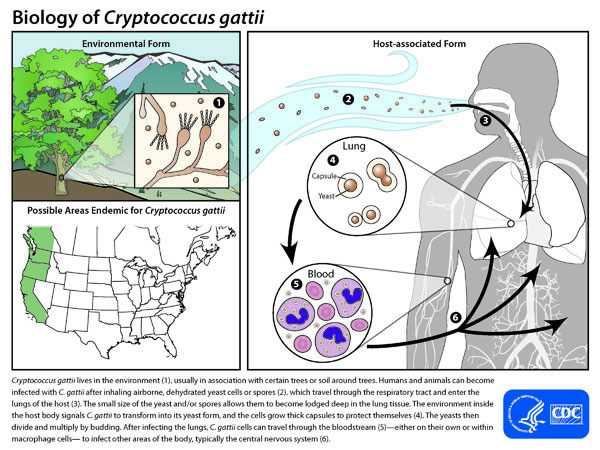Sources of C. gattii
Where does C. gattii live?
C. gattii lives in the environment, usually near trees and in the soil around trees.1,2 The fungus primarily lives in tropical and sub-tropical areas of the world, particularly Australia and Papua New Guinea, and also in parts of Africa, Asia, Europe, Mexico, and South America.1,2 It also lives in mainland British Columbia, Vancouver Island, and the United States Pacific Northwest (Oregon and Washington). C. gattii may also live in other areas of the U.S. such as California and the Southeastern U.S., because a few people from these parts of the U.S. have gotten C. gattii infections without traveling outside of these areas.3
Life cycle of C. gattii
C. gattii infections are not contagious. Humans and animals can become infected with C. gattii after inhaling airborne, dried yeast cells or spores from the environment. C. gattii travels through the airway and enters the lungs. The body’s temperature allows C. gattii to transform into its yeast form, and the cells grow thick outer layers to protect themselves. The yeasts then divide and multiply by budding. After infecting the lungs, C. gattii can travel through the bloodstream to infect other areas of the body, such as the central nervous system.
Click here for the PDF version of image [PDF – 1 page] for printing.

I’m worried that C. gattii is in the environment near my home. Can someone test the trees or soil to find out if the fungus is there?
No, in this case, testing the environment for C. gattii isn’t likely to be useful. A sample that tests positive for Cryptococcus doesn’t necessarily mean that it’s a source of infection, and a sample that tests negative doesn’t necessarily mean that the fungus isn’t there. Also, there are no commercially-available tests to detect C. gattii in the environment. Testing environmental samples for C. gattii is currently only done for scientific research.
Species of Cryptococcus and genetic types of C. gattii
The genus Cryptococcus contains over 30 species, but two species, Cryptococcus neoformans and Cryptococcus gattii, cause nearly all cryptococcal infections. Cryptococcus gattii used to be called Cryptococcus neoformans var. gattii, but it was determined to be a separate species from C. neoformans in 2002.4 C. neoformans and C. gattii tend to affect different patient populations. C. neoformans most often causes meningitis in people who have HIV infection or who are otherwise immunocompromised. C. gattii affects healthy people as well as people who have weakened immune systems, and it usually infects the lungs, the central nervous system, or both.
There are four known molecular types of C. gattii: VGI, VGII, VGIII, and VGIV. Type VGII can be further divided into the molecular subtypes VGIIa, VGIIb, and VGIIc. The different molecular types of C. gattii can be found in different parts of the world. Most C. gattii infections in British Columbia, Canada and the U.S. Pacific Northwest are caused by the molecular type VGII, but VGI is the most common type in Australia and Papua New Guinea.2 VGII appears to mostly cause lung infections, whereas the other types usually cause meningitis in people who don’t have any prior medical problems; however, scientists are still learning about the differences between the types of C. gattii.
References
- Springer DJ, Chaturvedi V. Projecting global occurrence of Cryptococcus gattii. Emerg Infect Dis. 2010 Jan;16(1):14-20.
- Harris J, Lockhart S, Chiller T. Cryptococcus gattii: where do we go from here? Med Mycol. 2011 Sep 22.
- Harris JR, Lockhart SR, Sondermeyer G, Vugia DJ, Crist MB, D’Angelo MT, et al. Cryptococcus gattii Infections in Multiple States Outside the US Pacific Northwest. Emerg Infect Dis. 2013 Oct;19(10):1621-7.
- Kwon-Chung KB, T; Fell, JW; Diaz, M. Proposal to conserve the name Cryptococcus gattii against C. hondurianus and C. bacillisporus (Basidiomycota, Hymenomycetes, Tremellomycetidae). Taxon. 2002;51:804-6.
- Page last reviewed: December 16, 2015
- Page last updated: December 16, 2015
- Content source:


 ShareCompartir
ShareCompartir